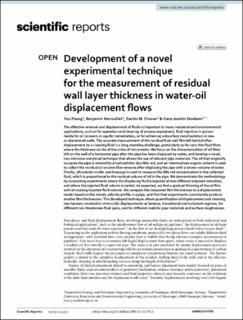| dc.contributor.author | Zhang, Yao | |
| dc.contributor.author | Barrouillet, Benjamin | |
| dc.contributor.author | Chavan, Sachin Maruti | |
| dc.contributor.author | Skadsem, Hans Joakim | |
| dc.date.accessioned | 2023-05-02T08:03:49Z | |
| dc.date.available | 2023-05-02T08:03:49Z | |
| dc.date.created | 2023-03-20T12:09:37Z | |
| dc.date.issued | 2023 | |
| dc.identifier.citation | Zhang, Y., Barrouillet, B., Chavan, S. M., & Skadsem, H. J. (2023). Development of a novel experimental technique for the measurement of residual wall layer thickness in water-oil displacement flows. Scientific Reports, 13(1), 4530. | en_US |
| dc.identifier.issn | 2045-2322 | |
| dc.identifier.uri | https://hdl.handle.net/11250/3065683 | |
| dc.description.abstract | The effective removal and displacement of fluids is important in many industrial and environmental applications, such as for operation and cleaning of process equipment, fluid injection in porous media for oil recovery or aquifer remediation, or for achieving subsurface zonal isolation in new or abandoned wells. The accurate measurement of the residual fluid wall film left behind after displacement by a cleaning fluid is a long-standing challenge, particularly so for very thin fluid films where the thickness can be of the order of micrometer. We focus on the characterization of oil films left on the wall of a horizontal pipe after the pipe has been displaced by water, and develop a novel, non-intrusive analytical technique that allows the use of relevant pipe materials. The oil that originally occupies the pipe is stained by a hydrophobic dye Nile red, and an intermediate organic solvent is used to collect the residual oil volume that remains after displacing the pipe with a known volume of water. Finally, ultraviolet-visible spectroscopy is used to measure the Nile red concentration in the collected fluid, which is proportional to the residual volume of oil in the pipe. We demonstrate the methodology by conducting experiments where the displacing fluid is injected at two different imposed velocities, and where the injected fluid volume is varied. As expected, we find a gradual thinning of the oil film with increasing injected fluid volume. We compare the measured film thicknesses to a displacement model based on the steady velocity profile in a pipe, and find that experiments consistently produce smaller film thicknesses. This developed technique allows quantification of displacement and cleaning mechanisms involved in immiscible displacements at laminar, transitional and turbulent regimes, for different non-Newtonian fluid pairs, and for different realistic pipe materials and surface roughnesses. | en_US |
| dc.language.iso | eng | en_US |
| dc.publisher | Nature | en_US |
| dc.rights | Navngivelse 4.0 Internasjonal | * |
| dc.rights.uri | http://creativecommons.org/licenses/by/4.0/deed.no | * |
| dc.title | Development of a novel experimental technique for the measurement of residual wall layer thickness in water-oil displacement flows | en_US |
| dc.type | Peer reviewed | en_US |
| dc.type | Journal article | en_US |
| dc.description.version | publishedVersion | en_US |
| dc.rights.holder | The authors | en_US |
| dc.subject.nsi | VDP::Teknologi: 500 | en_US |
| dc.source.journal | Scientific Reports | en_US |
| dc.identifier.doi | 10.1038/s41598-023-31776-5 | |
| dc.identifier.cristin | 2135277 | |
| cristin.ispublished | true | |
| cristin.fulltext | original | |
| cristin.qualitycode | 1 | |

